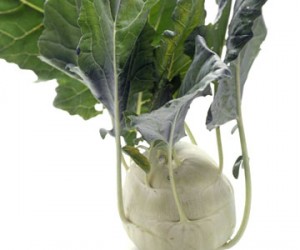Kohlrabi is not a very popular vegetable in the US today, but its subtle taste and crunchy texture make it one that likely to be enjoyed by you and your family. As a member of the Brassica family, kohlrabi is closely related to cabbage, broccoli, cauliflower, and brussels sprouts. The taste is mild and slightly sweet, and the small varieties can be as juicy as an apple.
Kohlrabi is low calorie (only 20 calories in ½ cup raw), and high in nutrients. A single ½ cup serving has potassium, vitamin A, vitamin C, folic acid, and calcium. In the same serving, there is also 2.5 grams of fiber!
The name Kohlrabi is German in origin and means “ cabbage turnip”. The Roman Empire Charlemagne gave this name around the 9th century. Hindu cuisine came across the vegetable around 1600, where it became a staple in their cooking as well. Today, the kohlrabi is common in African, Chinese, and Israeli cooking.
Small kohlrabi, with a radius of 1.5-2 inches, is ideal. These will be the juiciest and do not require peeling. The larger varieties have a tough skin that should be removed for optimal taste. The greens should still be attached and have no yellowing (yellowing indicates lack of freshness). With the greens still attached, the vegetable can be stored in the refrigerator for up to one month.
Kohlrabi can be enjoyed fresh or cooked. They are great sliced up in salads, paired with a little vegetable dip or just plain. The stems and leaves are also edible; they can be incorporated into the salad. The leaves are a similar texture and appearance to spinach. Another way to enjoy kohlrabi is steamed or as a cooked vegetable in any soup.
Here’s an easy recipe for a roasted kohlrabi:
1 1/2 pounds fresh kohlrabi, ends trimmed, thick green skin sliced off with a knife, diced
1 tablespoon olive oil
1 tablespoon garlic (garlic is optional, to my taste)
Salt
Good vinegar
Set oven to 450F. Toss the diced kohlrabi with olive oil, garlic and salt in a bowl. (The kohlrabi can be tossed with oil and seasonings right on the pan but uses more oil.) Spread evenly on a rimmed baking sheet and put into oven (it needn’t be fully preheated) and roast for 30 – 35 minutes, stirring every five minutes after about 20 minutes. Sprinkle with a good vinegar (probably at the table so the kohlrabi doesn’t get squishy).
In early summer, a great place to find kohlrabi is a local farmers market. I bought 3 beautiful kohlrabis this morning, and can’t wait to cook them up for dinner!
Research assistance by Kaylee O’Connell

